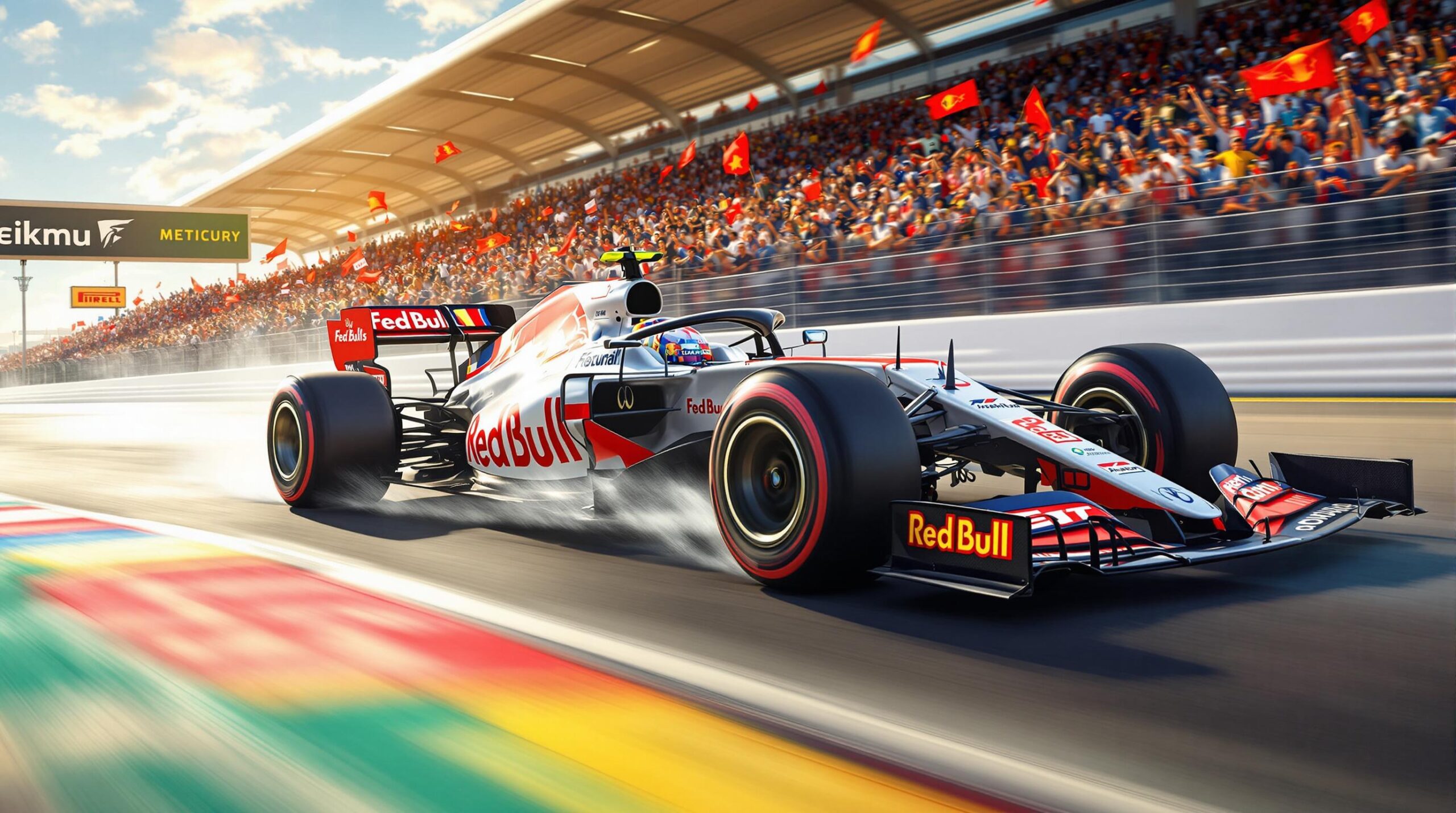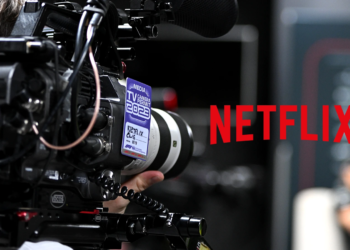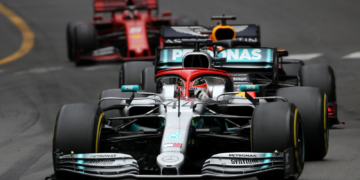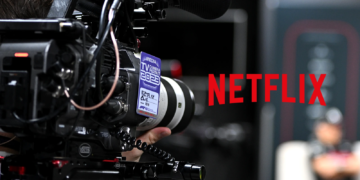Formula 1 sponsorships are a powerful way for brands to gain global exposure, connect with diverse audiences, and achieve measurable marketing goals. Here’s what you need to know:
Key Takeaways:
- Sponsorship Costs: Entry-level deals start at $1M/year; top-tier partnerships can reach $50M/year.
- Sponsorship Types:
- Team Partnerships: Includes Title, Principal, Technical, and Supplier levels.
- Event Sponsorships: Race naming rights, track visibility, and fan activations.
- Digital Media: Branded content, F1 TV ads, and esports collaborations.
- Success Metrics: Track brand awareness, audience engagement, and ROI using tools like Zoomph and Nielsen Sports.
- Risk Management: Vet partners include exit clauses and comply with F1 regulations.
Quick Tips:
- Align sponsorships with your brand’s values and target audience.
- Focus on digital and sustainable strategies to stay relevant.
- Use data-driven tools to measure and optimize sponsorship performance.
F1 sponsorships are not just about logo placements – they’re about building meaningful connections with fans and driving real business results. Read on for a step-by-step guide to crafting a winning strategy.
The Insane Economics of F1 Sponsors
Sponsorship Options in F1
Formula 1 provides sponsorship opportunities tailored to different budgets and goals, giving brands multiple ways to connect with the sport’s global audience.
F1 Team Partnerships
Partnering with an F1 team is one of the most involved sponsorship options. These partnerships are divided into several levels, each offering unique benefits:
| Partnership Level | Key Benefits |
|---|---|
| Title Partnership | Prominent branding on the car, team naming rights, and full-scale marketing integration |
| Principal Partner | High-visibility branding on the car and team assets, plus exclusive hospitality access |
| Technical Partner | Collaborative technology development, technical projects, and R&D opportunities |
| Official Supplier | Product use by the team, limited branding, and B2B networking opportunities |
Race and Event Sponsorships
Sponsoring a Grand Prix gives brands focused exposure during specific race weekends. A recent example is the LVMH Group‘s high-profile deal with Formula One [2].
Key event sponsorship options include:
- Track Visibility: Naming rights for circuits and strategic signage placements
- Hospitality Packages: High-end guest experiences and networking opportunities
- Fan Zone Activations: Interactive experiences to connect directly with attendees
Digital Media Sponsorships
As digital engagement becomes increasingly important, F1’s digital platforms offer brands modern avenues to reach fans worldwide. These options complement traditional sponsorships and open doors to new audiences.
Digital sponsorship opportunities include:
- Branded Content: Custom campaigns across social media and other digital platforms
- F1 TV Integration: Advertising and branded content within F1 TV and broadcast partnerships
- Esports Partnerships: Collaborations within virtual racing competitions
For example, Dell and McLaren Racing have successfully used data-driven campaigns to boost engagement and return on investment. Tools like Zoomph help brands track the effectiveness of their sponsorships and make real-time adjustments.
These options allow brands to align their strategies with F1’s global reach and fan engagement opportunities.
Creating an F1 Sponsorship Plan
To craft an impactful F1 sponsorship plan, set measurable goals aligning with your marketing strategy. Let’s break it down step by step.
Define Sponsorship Objectives
Clear objectives are key to measuring success. Here’s a quick breakdown of common goals and their metrics:
| Objective Category | Key Performance Indicators |
|---|---|
| Brand Awareness | Media coverage, social mentions |
| Audience Engagement | Fan interaction rates, content performance |
| Business Growth | Sales increases, lead generation |
| Market Penetration | Geographic reach, market share growth |
Choose Sponsorship Partners
Selecting the right F1 partner can make or break your strategy. Consider these factors:
- Performance history and global reach of the team or driver.
- Alignment with your target audience – Does the fanbase match your customer demographic?
- Brand value compatibility – Ensure your brand and the partner share similar values.
“The best sponsorships and the best partners that we work with are the ones that have a brand narrative that directly links what they do in the sport.” – Marc Cutler, Head of Communications at Right Formula [5]
A great example is Komatsu’s collaboration with Williams Engineering Academy. This partnership goes beyond traditional sponsorship by supporting STEM education initiatives [5].
Contract Terms and Rights
A well-structured contract ensures clarity and mutual benefits. Here are the key components to focus on:
| Contract Component | Key Considerations |
|---|---|
| Exclusivity Rights | Restrictions on competitor involvement |
| Activation Rights | Content usage, hospitality access |
| Performance Metrics | Agreed-upon metrics and reporting |
| Duration & Renewal | Contract length, extension options |
Sponsorship Activation
Activation is where the sponsorship comes to life and connects your goals with measurable results. Modern approaches include:
- Digital and data-driven campaigns to target specific audiences.
- Trackside brand experiences that engage fans in person.
- Immersive VR/AR experiences to create memorable interactions.
- Collaborative marketing efforts that boost fan engagement.
With over 300 brands involved and a 46.8% rise in US-based partners at the start of the 2024 season [5], it’s clear that sponsorship success requires more than financial backing. Tools like Zoomph can help track real-time performance and fine-tune strategies.
Measuring Sponsorship Results
Performance Metrics
To evaluate sponsorships effectively, combining traditional and digital metrics offers a complete picture of performance.
| Metric Category | Key Indicators | Measurement Tools |
|---|---|---|
| Media & Digital Impact | TV viewership, social engagement, website traffic | Nielsen Sports tracking, digital analytics |
| Brand Performance | Recognition, sentiment analysis | Brand awareness surveys |
| Commercial Value | Sales correlation, lead generation | ROI analysis tools |
Once you’ve identified the right metrics, setting up reliable systems to track and analyze them is the next step.
Measurement Systems
Modern F1 sponsorships rely on cutting-edge tracking tools. For instance, Nielsen Sports offers real-time monitoring that helps brands evaluate their sponsorship performance and adjust strategies as needed [3].
Here are two essential approaches:
- Integrated campaign monitoring: This involves tracking media coverage, digital interactions, and social engagement as they happen.
- Brand health tracking: Regularly measuring brand perception and awareness to gauge sponsorship effectiveness.
With the right tools, brands can turn data into actionable insights, driving measurable success.
Success Stories
A standout example is the Mercedes-Petronas partnership, which highlights the power of clear metrics and collaborative technical efforts. This partnership has shown measurable growth in brand value.
In today’s F1 sponsorships, it’s no longer just about logo placement. Brands must focus on fostering meaningful connections between teams, fans, and their values [4].
Common Sponsorship Issues
Legal Requirements
F1 sponsorship deals operate within a maze of regulations, including the FIA’s International Sporting Code and Formula One World Championship commercial rules. These rules set clear boundaries for how brands can participate.
Here are some of the key legal factors to consider:
| Requirement | Description | Impact |
|---|---|---|
| Advertising Restrictions | Limits on promoting certain products like tobacco and alcohol | Forces brands to find creative branding solutions |
| IP Rights | Ensures protection of intellectual property for teams and sponsors | Defines how logos, names, and designs can be used |
| Anti-corruption Compliance | Requires adherence to FIA’s anti-corruption policies | Shapes contract terms and partnership guidelines |
In addition to legal compliance, brands must carefully manage reputational risks to thrive in the F1 sponsorship landscape.
Brand Risk Management
Risk assessment is a critical step in securing successful F1 sponsorships. A high-profile example is the Rich Energy-Haas F1 Team fallout, highlighting the importance of thorough vetting [3].
To safeguard their reputation, brands should:
- Run detailed background checks on potential partners
- Set clear and measurable performance benchmarks
- Include strong exit clauses in contracts to manage unforeseen issues
- Foster open and transparent communication with all stakeholders
While managing risks is essential, staying ahead of the curve is equally important in this fast-changing sport.
Future-Proofing Partnerships
F1 is evolving, and sponsorship strategies need to keep up. Sustainability is now a major focus, as seen in Aggreko‘s partnership to deliver low-carbon energy at European Grands Prix [2].
“The sport’s increasing focus on sustainability and digital engagement requires brands to adapt their sponsorship strategies accordingly.”
Brands that thrive in F1 are embracing strategies like:
- Digital-First Activation: Using social media and online platforms to create engaging content.
- Youth Engagement: Collaborating with companies like Lego and Mattel to appeal to younger fans [2].
- Sustainable Innovation: Aligning with F1’s push for eco-friendly initiatives.
McLaren’s partnership with Castore is a great example of blending traditional sponsorship elements with modern approaches, showing how brands can stay relevant in this dynamic environment [1].
F1 sponsorship provides a strong platform for marketing, as seen in partnerships like Mercedes-Petronas, which boosted their brand value by 25% between 2014 and 2019. To succeed, brands need to align sponsorship choices with their goals, plan carefully, and be prepared to manage risks effectively.
The F1 sponsorship landscape is shifting. Digital media sponsorships are now critical, and partnerships focused on eco-friendly initiatives are becoming more important as consumer expectations evolve.
Next Steps
To kick off a successful F1 sponsorship, brands can follow these steps:
- Evaluate your brand’s fit with F1 opportunities: Consider your budget and look for partnerships that align with your values.
- Seek expert guidance: Work with F1 specialists to understand market trends and use tools like Nielsen Sports to measure ROI.
- Create a focused strategy: Set clear goals, outline activation plans, and include risk management measures.
Starting small with focused initiatives can be a smart way to enter the F1 sponsorship world. This lets brands experiment and refine their approach based on performance and insights.
FAQs
How effective is F1 sponsorship for a brand?
F1 sponsorship has proven to be a powerful marketing tool. Over 40% of consumers are more inclined to buy from long-term F1 sponsors, highlighting the impact of sustained partnerships. For example, LVMH’s $1.5 billion, 10-year deal underscores the marketing potential of F1 [2]. Brands like Shell and Santander have also seen success, leveraging F1’s focus on innovation to boost recognition and customer loyalty [1].
Key factors that influence sponsorship success include:
| Factor | Impact |
|---|---|
| Partnership Duration | Long-term deals build consumer trust and increase purchase intent. |
| Brand Alignment | Shared values between the brand and F1 enhance partnership results. |
| Digital Integration | Combining traditional and online strategies broadens audience reach. |
| Performance Tracking | Tools like Nielsen Sports help measure and improve sponsorship ROI. |
By focusing on these elements, brands can create partnerships that deliver strong returns and align with their goals. The rise of digital sponsorships also provides brands new ways to engage audiences and expand their reach [1].
These insights can guide brands in designing smarter sponsorship strategies, ensuring they stay in tune with F1’s dynamic environment.









